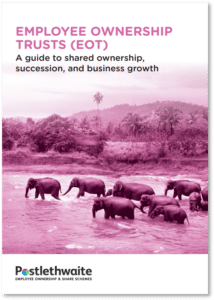An EOT is a trust that enables a company to become owned by its employees and can be set up by a company’s existing owners, perhaps as part of their exit or succession planning strategy, or by founders starting a new business which they wish to be employee-owned. It was created by the Finance Act 2014, to encourage more companies to become employee owned.
Join our upcoming ‘How to become Employee Owned Webinar’ @11am on Tuesday 30th September
With our Founder and Managing Director, Robert Postlethwaite and our client Jude Bond-Kelly of Hawthorn Estates – it’s the perfect starting place for anyone considering a move to employee ownership. Featuring actionable insights and inspiring real-world experience from a business that’s been there.
To register visit the eoa website here.

Download our essential guide to Employee Ownership Trusts (EOTs)
Importantly for many business owners, an EOT creates two tax breaks:
- Those selling their shares may do so free of capital gains tax
- Once a company is owned by an EOT, it can pay annual bonuses to its employees free of income tax
There are two main conditions to enable the tax breaks:
- The trust must hold more than 50% of the shares in the company
- If employees receive any benefit from the trust, they must all be included and on the same terms
How is an employee ownership trust funded?
Normally, an EOT will acquire a controlling interest in a company from its current shareholders.
Commonly, a price will be agreed (based on an independent assessment) which must not be more than market value and payment will then be made in instalments, the EOT being funded by the company from its future profits. Occasionally, a company owner will give their shares to the EOT but in most cases they will wish to be paid. Sometimes it is possible to arrange an external loan which will enable the purchase price (or a larger part of it) to be paid in one go.
Who manages the EOT?
An EOT will be run by its trustees. Their role will not be to manage the company (this continues to be the role of the management team) but to ensure the company is being well led and in a way which maximises employee engagement and commitment. This is sometimes facilitated by the creation of an employees’ council.
Watch the video below to get a good understanding of how it works in practice.
Employee ownership trust tax reliefs
- FULL RELIEF AGAINST CAPITAL GAINS TAX
The sale of a controlling interest in a business to an employee ownership trust (EOT) will be entirely free from capital gains tax (CGT).
What is an employee ownership trust?
An EOT must meet the following requirements:
- The company whose shares are transferred must be a trading company or, where there is a group, the principal company of a trading group. A company which has significant cash, land or other investments may not be a trading company.
- The EOT must meet the “all-employee benefit requirement” – see below.
- The EOT must not hold a controlling interest of more than 50% in the company before the transfer to it. However, the EOT must hold a controlling interest in the company at the end of the tax year in which the transfer to it takes place.
- Where the transferor has an interest of 5% or more in the company in the 12 months before he transfers his shares to the EOT there is an additional requirement. The requirement is that the number of employees who hold 5% or more of the company must not exceed two fifths (2/5) of the workforce generally. (please see the worked example below.)
Example of the 2/5 ratio in operation : CGT relief
A company has 3 people who each hold more than 5% of the Company’s shares and are employees or directors (Shareholder Employees). and a total of 9 people who are employees. On the face of it, the ratio will be 3/9 which would satisfy this ratio requirement. If, however, one of the 9 is, for example, the son of one of the Shareholder Employees, he will be counted in with the Shareholder Employees as a relative. The ratio will become 4/9 which will not satisfy the requirement and it will not be possible for any selling shareholder to claim the CGT exemption.
This is a complicated aspect and specific advice may be required in individual circumstances.
What is the “all-employee benefit requirement”?
Broadly, if the EOT provides benefits (such as cash or shares) to individual employees, it must generally do so in favour of all eligible employees, and must do so on the same terms (separately called the “equality requirement”).
The EOT cannot, therefore, skew benefits to the advantage of particular employees, although it can allocate benefits of differing amounts by reference to factors such as salary, length of service or hours worked. “Employees” can also include certain dependants of deceased employees. Anyone personally holding 5% or more of the company’s shares (or who has done) may not be a beneficiary of the EOT.
- INCOME TAX FREE BONUSES
Bonuses paid to employees of companies controlled by an EOT benefit from an income tax (but not national insurance) exemption.
What are the conditions for the income tax relief?
The key requirements for income tax relief are:
- The employer company must be a trading company or a member of a trading group.
- A controlling interest in the company or, in a group of companies, the principal company in the group, must be held by an EOT, for at least twelve months.
- Provisions very similar to the equality requirement for the CGT exemption also apply to the income tax exemption.
- The company should not have more than a ratio of 2/5 for directors (plus any employees related to them) to employees and directors in total. (Please see the worked example below.)
- There is a maximum limit of £3,600 income tax free bonus per employee per tax year
- The payment must not consist of normal salary, must not be made by a service company and must be made under an arrangement under which:
- all employees of the company, or, where there is a group, any group company must be eligible to participate in any award (although employees with continuous service of less than 12 months can be excluded); and
- all employees participating in the arrangement must do so on equal terms (although awards can be determined by reference to pay, length of service or hours worked).
Example of the 2/5 ratio in operation: income tax free bonuses
A company has 3 people who are directors and 9 people who are either employees or directors. On the face of it, the ratio will be 3/9 which would satisfy this ratio requirement. If, however, one of the 9 is, for example, the son of one of the directors, he will be counted in with the directors as a relative. The ratio will become 4/9 which will not satisfy the requirement and it will not be possible to pay income tax free bonuses.
This is a complicated aspect and specific advice may be required in individual circumstances.
Employee ownership can offer the following benefits for:
For a private company owner wishing to retire but looking for an alternative to a trade sale, an EOT is certainly worth considering. It places the business in the hands of people who understand what makes it tick, have a strong personal commitment to its long term success and are highly motivated by their ownership to make it thrive.
- Realise the value built up in your business
- Leadership succession can be implemented over time
- Peace of mind that the business is in good hands
- Legacy
- Tax reliefs
- A solid foundation for future growth
- Helps create a more resilient and adaptable business
- Preservation of the business' values and culture
- Increased productivity
- More engaged, committed and motivated - clear shared purpose
- No personal investment or changes to their employment required
- Full share in the rewards of success - a tax free bonus (limits apply)
- Enables targeted rewards for key people if required
Do employees hold shares personally?
Not necessarily. The EOT will hold shares on behalf of all employees and it will often not be necessary to include a feature in which individual employees each hold their own shares. However, it is possible to have an ownership arrangement under which the EOT holds a majority of the shares but also giving all employees their own personal shareholding.
For some EOT-owned companies, it is important to have a long term reward arrangement for directors or other key employees, and this can take the form of a share option or ownership scheme targetted at them (for example EMI options or CSOP options). Please note that as the shares here cannot come from the EOT (if it passes shares to employees, it must do so to all of them), they must be new shares issued by the company or perhaps be shares that the original owners have not sold to the EOT

We realised the only way to ensure our values-led culture and to ensure the legacy of what we had built up was actually through an Employee Ownership Trust
Val King, The Rooflight Company
Might an EOT be right for your company?
Employee ownership has the potential, by sharing the rewards of your company’s success with its employees, to create a powerful incentive to engage in the business and work together to improve its performance for everyone’s benefit. You can find more evidence on our Employee Ownership page.
You should consider an EOT if:
- You are looking how to retire from the ownership of your company in a way which creates a strong platform for future success in the interests of you, your business and its people, or
- You don’t feel a trade sale or management buyout is feasible or the best solution, or
- You want to start a new business with maximally committed and engaged people and a strong shared purpose, or
- You work in a business which needs to find a succession solution but has not been able to do so.

To explore how an Employee Ownership Trust could work for your company, please call us on 020 3818 9420 or email info@postlethwaiteco.com.

 Interested to find out more? Contact us for a no obligation chat with one of the team
Interested to find out more? Contact us for a no obligation chat with one of the team